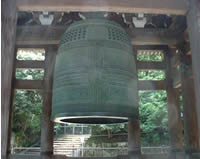 |
Temple
Bell Chion-in Temple, Kyoto |
Omisoka, New Year’s Eve, is an important day in Japanese tradition, as it is the day before the most important holiday of the year: New Year.
It is common to clean the whole house on this day, a ritual called Ôsouji, which literally means “big cleanup”; primary schools also perform Ôsouj before they go into their winter vacation.
The newly cleaned home is festooned with special
images. A kadomatsu—made
of pine boughs, bamboo and straw and said
to have the power to attract good fortune—is
placed on either side of the front entrance. Over
the door is hung a shimekazari,
a decoration which indicates that the home has now been purified and thus
ready to welcome the divinities which, according to a popular belief,
have the power to bring happiness and to ward off evil spirits.
On
Omisoka it is traditional to eat noodles to see the old year out; at
the very end of the day, usually around 11 o'clock at night, special noodles
called toshikoshi-udon—literally “crossover year
noodle”—are consumed.
A few minutes before midnight, crowds gather at the temple to hear the bell struck 108 times, a precaution intended to drive away all of the previous year’s sins and thus ensuring a fresh new start.